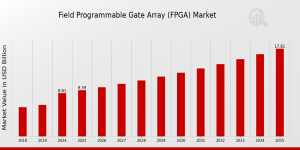Global FPGA Market to Reach USD 17.81 Billion by 2035 at 6.61% CAGR
Field Programmable Gate Array (FPGA) Market Research Report By Technology, Application, End Use, Product Type, Regional.
CA, UNITED STATES, August 5, 2025 /EINPresswire.com/ -- Powering the Future: The Global Field Programmable Gate Array (FPGA) Market on a High-Growth TrajectoryThe landscape of modern electronics is defined by an insatiable demand for performance, flexibility, and efficiency. At the heart of this technological evolution lies the Field Programmable Gate Array (FPGA) market, a critical sector enabling a new generation of high-speed, adaptable computing.
FPGAs are semiconductor devices that can be reconfigured after manufacturing, allowing designers to create custom hardware circuits for specific applications. This unique ability to marry the speed of hardware with the flexibility of software is driving unprecedented innovation and market growth.
Download Sample Pages: https://www.marketresearchfuture.com/sample_request/1019
Valued at an impressive $8.81 billion in 2024, the global FPGA market is not merely growing—it is accelerating. Projections indicate a substantial increase to $17.81 billion by 2035, a trajectory underscored by a robust Compound Annual Growth Rate (CAGR) of 6.61% from 2024 to 2032. This powerful momentum is a clear indicator of FPGAs’ pivotal role in key technological sectors that are defining the future.
Key Drivers Fueling Market Expansion
The market's robust growth is propelled by several major technological and economic trends. FPGAs are uniquely positioned to address the complex challenges posed by these evolving demands.
• High-Performance Computing (HPC) and Data Centers: FPGAs have become a cornerstone of modern data centers and HPC environments. Their parallel processing architecture allows them to handle massive, computationally intensive tasks—such as scientific simulations, big data analytics, and machine learning inference—with far greater efficiency and lower latency than traditional CPUs or GPUs. By offloading these demanding workloads, FPGAs act as hardware accelerators, dramatically boosting performance while significantly reducing energy consumption, a critical factor for hyperscale data centers.
• The Proliferation of IoT Devices: The Internet of Things (IoT) is generating an immense volume of data at the "edge," far from centralized data centers. FPGAs are ideal for edge computing due to their low-power consumption, real-time processing capabilities, and customizable nature. They can be programmed to handle a variety of tasks, from sensor data fusion and real-time video analytics to secure communication, enabling intelligent decision-making directly at the device level without relying on cloud connectivity.
• Advanced Communication Technologies: The rollout of 5G and beyond is creating a significant demand for high-speed, low-latency, and reconfigurable network infrastructure. FPGAs are instrumental in 5G base stations, where they enable real-time signal processing, efficient handling of massive MIMO (Multiple-Input Multiple-Output) technology, and dynamic beamforming. Their reprogrammability is a distinct advantage, as it allows network hardware to be updated to new standards and protocols without requiring expensive and time-consuming hardware replacements.
Browse In depth Market Research Report: https://www.marketresearchfuture.com/reports/field-programmable-gate-array-market-1019
Key Companies in the Field Programmable Gate Array (FPGA) Market Include
• Vantis
• PolarFire
• Nallatech
• Lattice Semiconductor
• Achronix
• Intel
• Xilinx
• Gowin Semiconductor
• Efinix
• QuickLogic
• Dialog Semiconductor
• Microsemi
• Actel
Strategic Applications Across Key Industries
The adaptability of FPGAs has made them a foundational technology in some of the world's most dynamic and critical industries.
• Automotive: The automotive sector is undergoing a profound transformation towards autonomous vehicles and Advanced Driver-Assistance Systems (ADAS). FPGAs are essential in this domain for their ability to perform real-time sensor fusion, a process that combines data from cameras, LiDAR, and radar to create a comprehensive understanding of the vehicle’s surroundings. Their low-latency processing and high reliability also make them crucial for safety-critical applications, helping systems comply with stringent standards like ISO 26262.
• Telecommunications: In addition to 5G infrastructure, FPGAs are used extensively in optical networking, network acceleration, and test and measurement equipment. Their flexibility allows telecom companies to rapidly prototype and deploy new network functions, ensuring they can keep pace with the exponential growth of data traffic.
• Aerospace and Defense: This sector relies on FPGAs for their robustness, reliability, and security features. FPGAs are used in satellite communication systems, radar, and electronic warfare applications. Radiation-hardened FPGAs are specifically designed to withstand the harsh conditions of space, while their reprogrammability allows for in-field updates to counter evolving threats and ensure mission success.
Technological Advancements and Competitive Landscape
The growth of the FPGA market is supported by continuous technological advancements. Manufacturers are developing more sophisticated devices with higher logic density, lower power consumption, and integrated hard IP blocks for common functions.
The rise of System-on-Chip (SoC) FPGAs, which combine a traditional FPGA fabric with embedded processors (like ARM cores) on a single chip, is further expanding their application range by offering a powerful balance of parallel processing and software programmability.
The competitive landscape is dominated by a few major players who are driving innovation and market direction. Leading companies, including AMD (which acquired Xilinx), Intel (formerly Altera), Lattice Semiconductor, and Microchip Technology, are at the forefront of this market. These companies are heavily investing in research and development to produce smaller, more efficient, and more integrated solutions, often targeting niche applications like edge AI and specialized networking.
Procure Complete Research Report Now: https://www.marketresearchfuture.com/checkout?currency=one_user-USD&report_id=1019
Conclusion
The Field Programmable Gate Array market is poised for a period of sustained and accelerated growth. Its ability to provide a unique combination of high performance, flexibility, and energy efficiency makes it an indispensable technology for an increasingly data-driven world.
From powering the backbone of next-generation communication networks and enabling the safety-critical systems in autonomous vehicles to acting as the intelligent brain of IoT devices, FPGAs are not just keeping pace with technological change—they are actively shaping it. The projected growth to $17.81 billion by 2035 is a testament to the essential and enduring role FPGAs will play in the future of technology.
Related Reports:
Driver Assistance System Market: https://www.marketresearchfuture.com/reports/driver-assistance-system-market-794
Wireless Audio Device Market: https://www.marketresearchfuture.com/reports/wireless-audio-devices-market-802
CMOS and sCMOS Image Sensor Market: https://www.marketresearchfuture.com/reports/cmos-scmos-image-sensor-market-909
Smart Lighting Market: https://www.marketresearchfuture.com/reports/smart-lighting-market-991
Metrology Market: https://www.marketresearchfuture.com/reports/metrology-market-1064
3D Sensor Market: https://www.marketresearchfuture.com/reports/3d-sensor-market-1104
Mechanical Keyboard Market: https://www.marketresearchfuture.com/reports/mechanical-keyboard-market-1215
3D IC Market: https://www.marketresearchfuture.com/reports/3d-ic-market-1763
Semiconductor Inspection System Market: https://www.marketresearchfuture.com/reports/semiconductor-inspection-system-market-1797
Oscilloscope Market: https://www.marketresearchfuture.com/reports/oscilloscope-market-1873
Comprehensive Report on the Plant-Based Protein Market: Opportunities and Challenges
Pea Protein Ingredients Industry Report: Competitive Landscape and Future Prospects
Food Preservatives Market Trends and Analysis by Application, Vertical, Region, and Segment Forecast to 2029
Więcej ważnych informacji
 Jedynka Newserii
Jedynka Newserii

 Jedynka Newserii
Jedynka Newserii

Polityka

D. Joński: Nie wiemy, co zrobi Rosja za dwa–trzy lata. Według duńskiego wywiadu może zaatakować kraje nadbałtyckie i musimy być na to gotowi
Zdecydowana większość krajów unijnych wskazuje na potrzebę wzmocnienia zdolności obronnych Europy w obliczu coraz bardziej złożonego geopolitycznego tła. Wywiady zachodnich państw wskazują, że Rosja może rozpocząć konfrontację z NATO jeszcze przed 2030 rokiem. Biała księga w sprawie obronności europejskiej „Gotowość 2030” zakłada m.in. ochronę granic lądowych, powietrznych i morskich UE, a sztandarowym projektem ma być Tarcza Wschód. – W budzeniu Europy duże zasługi ma polska prezydencja – ocenia europoseł Dariusz Joński.
Transport
Duże magazyny energii przyspieszą rozwój transportu niskoemisyjnego w Europie. Przyszłością może być wodór służący jako paliwo i nośnik energii

Zmiany w europejskim transporcie przyspieszają. Trendem jest elektromobilność, zwłaszcza w ramach logistyki „ostatniej mili”. Jednocześnie jednak udział samochodów w pełni elektrycznych w polskich firmach spadł z 18 do 12 proc., co wpisuje się w szerszy europejski trend spowolnienia elektromobilności. Główne bariery to ograniczona liczba publicznych stacji ładowania, wysoka cena pojazdów i brak dostępu do odpowiedniej infrastruktury. – Potrzebne są odpowiednio duże magazyny taniej energii. Przyszłością przede wszystkim jest wodór – ocenia Andrzej Gemra z Renault Group.
Infrastruktura
W Polsce w obiektach zabytkowych wciąż brakuje nowoczesnych rozwiązań przeciwpożarowych. Potrzebna jest większa elastyczność w stosowaniu przepisów

Pogodzenie interesów konserwatorów, projektantów, inwestorów, rzeczoznawców i służby ochrony pożarowej stanowi jedno z największych wyzwań w zakresie ochrony przeciwpożarowej obiektów konserwatorskich. Pożary zabytków takich jak m.in. katedra Notre-Dame w Paryżu przyczyniają się do wprowadzania nowatorskich rozwiązań technicznych w zakresie ochrony przeciwpożarowej. W Polsce obowiązuje już konieczność instalacji systemów detekcji. Inwestorzy często jednak rezygnują z realizacji projektów dotyczących obiektów zabytkowych z uwagi na zmieniające się i coraz bardziej restrykcyjne przepisy czy też względy ekonomiczne.
Partner serwisu
Szkolenia

Akademia Newserii
Akademia Newserii to projekt, w ramach którego najlepsi polscy dziennikarze biznesowi, giełdowi oraz lifestylowi, a także szkoleniowcy z wieloletnim doświadczeniem dzielą się swoją wiedzą nt. pracy z mediami.




![Nestlé w Polsce podsumowuje wpływ na krajową gospodarkę. Firma wygenerowała 0,6 proc. polskiego PKB [DEPESZA]](https://www.newseria.pl/files/1097841585/fabryka-nesquik_1,w_85,r_png,_small.png)




.gif)

 |
| |
| |
|